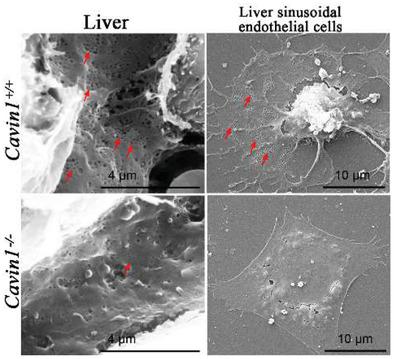Our official English website, www.x-mol.net, welcomes your
feedback! (Note: you will need to create a separate account there.)
Cavin1 Deficiency Causes Disorder of Hepatic Glycogen Metabolism and Neonatal Death by Impacting Fenestrations in Liver Sinusoidal Endothelial Cells
Advanced Science ( IF 14.3 ) Pub Date : 2020-08-21 , DOI: 10.1002/advs.202000963 Zhuang Wei 1, 2 , Jigang Lei 2, 3 , Feng Shen 4 , Yuxiang Dai 5 , Yan Sun 6 , Yilian Liu 1 , Yan Dai 2, 7 , Zhijie Jian 8 , Shilong Wang 3 , Zhengjun Chen 2, 7 , Kan Liao 2 , Shangyu Hong 1
Advanced Science ( IF 14.3 ) Pub Date : 2020-08-21 , DOI: 10.1002/advs.202000963 Zhuang Wei 1, 2 , Jigang Lei 2, 3 , Feng Shen 4 , Yuxiang Dai 5 , Yan Sun 6 , Yilian Liu 1 , Yan Dai 2, 7 , Zhijie Jian 8 , Shilong Wang 3 , Zhengjun Chen 2, 7 , Kan Liao 2 , Shangyu Hong 1
Affiliation

|
It has been reported that Cavin1 deficiency causes lipodystrophy in both humans and mice by affecting lipid metabolism. The ablation of Cavin1 in rodents also causes a significant deviation from Mendelian ratio at weaning in a background‐dependent manner, suggesting the presence of undiscovered functions of Cavin1. In the current study, the results show that Cavin1 deficiency causes neonatal death in C57BL/6J mice by dampening the storage and mobilization of glycogen in the liver, which leads to lethal neonatal hypoglycemia. Further investigation by electron microscopy reveals that Cavin1 deficiency impairs the fenestration in liver sinusoidal endothelial cells (LSECs) and impacts the permeability of endothelial barrier in the liver. Mechanistically, Cavin1 deficiency inhibits the RhoA‐Rho‐associated protein kinase 2‐LIM domain kinase‐Cofilin signaling pathway and suppresses the dynamics of the cytoskeleton, and eventually causes the reduction of fenestrae in LSECs. In addition, the defect of fenestration in LSECs caused by Cavin1 deficiency can be rescued by treatment with the F‐actin depolymerization reagent latrunculin A. In summary, the current study reveals a novel function of Cavin1 on fenestrae formation in LSECs and liver glycogen metabolism, which provide an explanation for the neonatal death of Cavin1 null mice and a potential mechanism for metabolic disorders in patients with Cavin1 mutation.
中文翻译:

Cavin1 缺陷通过影响肝窦内皮细胞的开窗导致肝糖原代谢紊乱和新生儿死亡
据报道,Cavin1 缺陷会影响脂质代谢,从而导致人类和小鼠脂肪营养不良。啮齿动物中 Cavin1 的消融也会以背景依赖性方式导致断奶时孟德尔比率的显着偏差,表明 Cavin1 存在未发现的功能。在当前的研究中,结果表明Cavin1缺陷通过抑制肝脏中糖原的储存和动员而导致C57BL/6J小鼠的新生儿死亡,从而导致致命的新生儿低血糖。电子显微镜进一步研究表明,Cavin1 缺陷会损害肝窦内皮细胞 (LSEC) 的开窗,并影响肝脏内皮屏障的通透性。从机制上讲,Cavin1缺陷抑制RhoA-Rho相关蛋白激酶2-LIM结构域激酶-Cofilin信号通路并抑制细胞骨架的动力学,最终导致LSECs窗孔减少。此外,Cavin1缺陷引起的LSECs开窗缺陷可以通过F-肌动蛋白解聚试剂latrunculin A治疗来挽救。综上所述,本研究揭示了Cavin1对LSECs开窗形成和肝糖原代谢的新功能。这为 Cavin1 缺失小鼠的新生儿死亡提供了解释,并为 Cavin1 突变患者代谢紊乱的潜在机制提供了解释。
更新日期:2020-10-07
中文翻译:

Cavin1 缺陷通过影响肝窦内皮细胞的开窗导致肝糖原代谢紊乱和新生儿死亡
据报道,Cavin1 缺陷会影响脂质代谢,从而导致人类和小鼠脂肪营养不良。啮齿动物中 Cavin1 的消融也会以背景依赖性方式导致断奶时孟德尔比率的显着偏差,表明 Cavin1 存在未发现的功能。在当前的研究中,结果表明Cavin1缺陷通过抑制肝脏中糖原的储存和动员而导致C57BL/6J小鼠的新生儿死亡,从而导致致命的新生儿低血糖。电子显微镜进一步研究表明,Cavin1 缺陷会损害肝窦内皮细胞 (LSEC) 的开窗,并影响肝脏内皮屏障的通透性。从机制上讲,Cavin1缺陷抑制RhoA-Rho相关蛋白激酶2-LIM结构域激酶-Cofilin信号通路并抑制细胞骨架的动力学,最终导致LSECs窗孔减少。此外,Cavin1缺陷引起的LSECs开窗缺陷可以通过F-肌动蛋白解聚试剂latrunculin A治疗来挽救。综上所述,本研究揭示了Cavin1对LSECs开窗形成和肝糖原代谢的新功能。这为 Cavin1 缺失小鼠的新生儿死亡提供了解释,并为 Cavin1 突变患者代谢紊乱的潜在机制提供了解释。











































 京公网安备 11010802027423号
京公网安备 11010802027423号